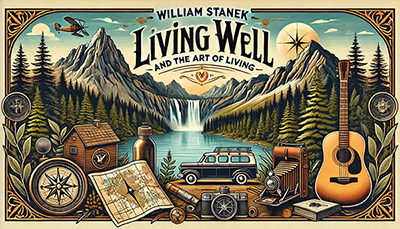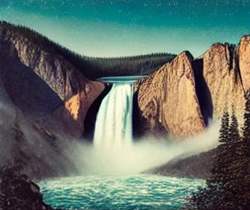
 Photography Tips for Everyday Moments
Photography Tips for Everyday Moments
The most extraordinary beauty is often found in ordinary moments. In this series, William Stanek helps you see the world through a new lens, transforming everyday experiences into stunning photographic memories.

Transform your life with practical wisdom. Discover William Stanek's 'Living Well' series—your guide to a balanced and fulfilling life.
Discover William Stanek's Exclusive Art Collection
Explore and purchase the stunning art featured on this site. Own a piece of William Stanek's unique and captivating artwork today!
(April 26, 2025) The Art of Visual Storytelling: Creating a Photo Essay
Photography is more than just capturing beautiful images—it's a powerful medium for storytelling. A photo essay, in particular, allows you to convey a narrative through a series of images, creating a visual journey that engages, informs, and moves the viewer. Whether you’re documenting a social issue, capturing the essence of a place, or telling a personal story, a well-constructed photo essay can leave a lasting impact. Here, we’ll explore the art of visual storytelling through photo essays, guiding you through the process of planning, shooting, and presenting your work.
Introduction: The Power of the Photo Essay
A photo essay is a collection of images that work together to tell a cohesive story. Unlike a single photograph, which captures a moment in time, a photo essay allows you to explore a subject in depth, showing different perspectives, moments, and emotions. It’s an opportunity to delve into a narrative, whether it’s the story of a person, a place, an event, or an idea.
Creating a compelling photo essay requires more than just technical skill—it involves careful planning, a clear vision, and a thoughtful approach to storytelling. By organizing your photos to create a narrative arc, choosing a cohesive theme, and curating your images for maximum impact, you can craft a photo essay that resonates with viewers and tells a story that is both powerful and memorable.
In this article, we’ll guide you through the key steps of creating a photo essay, from selecting a theme to editing and sequencing your images.
Story Structure: Organizing Your Photos to Create a Beginning, Middle, and End
Like any good story, a photo essay needs a clear structure—a beginning, middle, and end that guide the viewer through the narrative. Each image should serve a purpose, contributing to the overall story and helping to create a cohesive and engaging experience.
The Beginning: The opening of your photo essay sets the stage for the story. It introduces the subject, establishes the context, and piques the viewer’s interest. Your first image should be strong and evocative, drawing the viewer in and making them want to learn more. This could be a wide shot that establishes the setting, a portrait that introduces a key character, or a detail that hints at the theme of the essay.
The Middle: The middle section of your photo essay is where the narrative unfolds. This is where you explore the subject in depth, showing different angles, moments, and perspectives. The middle should build on the introduction, adding complexity and nuance to the story. This is the heart of your essay, where the majority of your images will be focused. Consider using a mix of wide shots, close-ups, and medium shots to create visual variety and maintain the viewer’s interest.
The End: The conclusion of your photo essay should bring the narrative to a satisfying close. It should provide resolution, whether it’s an emotional payoff, a final reflection, or a call to action. Your last image should leave a lasting impression, tying together the themes of the essay and providing a sense of closure. This could be a powerful portrait, a symbolic image, or a moment that encapsulates the story’s message.
Pro Tip: Think of your photo essay as a visual storybook. Each image should be like a page in a book, contributing to the overall narrative and leading the viewer from one part of the story to the next. Consider how each image connects to the one before it and sets up the one that follows.
Exercise: Choose a subject and create a mini photo essay with a clear beginning, middle, and end. Focus on organizing your images to tell a cohesive story, and experiment with different types of shots to create visual variety. Reflect on how the structure of the essay enhances the narrative and guides the viewer through the story.
Choosing a Theme: Selecting a Cohesive Theme or Narrative for Your Essay
The theme or narrative of your photo essay is the backbone of the project—it’s what ties all the images together and gives the essay its meaning and direction. Choosing a strong, cohesive theme is essential for creating a compelling photo essay.
Finding Your Theme: Your theme should be something that resonates with you personally and that you can explore in depth through photography. It could be a social issue, a cultural tradition, a community, a place, or even a personal journey. The key is to choose a theme that offers enough depth and variety to sustain a series of images and that allows you to tell a complete and engaging story.
Exploring the Theme: Once you’ve chosen a theme, think about the different aspects of it that you want to explore. What are the key moments, characters, and elements that define the theme? How can you show different perspectives and layers of the story through your images? Consider how you can use visual storytelling techniques—such as contrast, repetition, and symbolism—to deepen the viewer’s understanding of the theme.
Staying Focused: It’s important to stay focused on your theme throughout the process of creating your photo essay. While it’s natural to want to capture everything, a successful photo essay is usually more focused and selective. Choose images that contribute directly to the theme and avoid including shots that don’t serve the narrative. This focus will help to create a more cohesive and impactful essay.
Pro Tip: When choosing a theme, think about what makes it unique and visually interesting. Consider how you can capture the essence of the theme through your images, and how you can convey the story in a way that is both compelling and meaningful.
Exercise: Brainstorm a list of potential themes for a photo essay. Choose one that resonates with you and create a plan for how you will explore the theme through photography. Think about the key elements of the theme and how you can capture them in a way that tells a complete and cohesive story. Reflect on how the choice of theme shapes the direction of your photo essay.
Editing and Sequencing: How to Curate and Order Your Images for Maximum Impact
Editing and sequencing are critical steps in creating a successful photo essay. Once you’ve captured your images, you’ll need to carefully curate and arrange them to create a narrative that flows naturally and engages the viewer.
Curating Your Images: Start by reviewing all of the images you’ve captured and selecting the ones that best tell the story. Look for images that are strong, evocative, and essential to the narrative. Be selective—choose only the images that contribute directly to the story and that work well together as a series. Pay attention to the quality of each image, as well as its relevance to the theme and narrative.
Sequencing Your Images: Once you’ve selected your images, the next step is to arrange them in a sequence that creates a compelling narrative. Think about how the viewer’s experience will unfold as they move through the essay. The order of the images should guide the viewer’s eye and help to build the story, from the introduction through to the conclusion. Consider how the images flow together, both visually and thematically, and make adjustments as needed to create a smooth and engaging sequence.
Creating Visual Rhythm: In addition to narrative flow, think about the visual rhythm of your photo essay. This involves balancing different types of images—such as wide shots, close-ups, and medium shots—to create variety and maintain the viewer’s interest. You might also consider repeating certain visual motifs or themes to create a sense of cohesion and rhythm throughout the essay.
Pro Tip: When sequencing your images, think about how each image transitions to the next. The transitions should feel natural and intentional, leading the viewer smoothly from one part of the story to the next. If a transition feels jarring or out of place, consider reordering the images or selecting a different shot.
Exercise: Select a series of images from your photo essay project and experiment with different sequences. Try arranging the images in various orders to see how the narrative and flow change. Reflect on how the sequencing of the images affects the overall impact of the essay and how it guides the viewer’s experience.
Mastering the Art of Visual Storytelling Through Photo Essays
Creating a photo essay is a powerful way to tell stories through photography, offering the opportunity to explore a subject in depth and create a narrative that resonates with viewers. By focusing on story structure, choosing a cohesive theme, and carefully editing and sequencing your images, you can craft a photo essay that is both visually compelling and emotionally impactful.
The Photographer as Storyteller: In a photo essay, you are not just a photographer—you are a storyteller. Your images are the building blocks of the story, and the way you organize and present them determines how the story is told. By approaching your photo essay with intention, creativity, and sensitivity, you can create a narrative that speaks to the viewer and leaves a lasting impression.
Pro Tip: Always keep the viewer’s experience in mind when creating a photo essay. Think about how the images will be perceived and how they work together to create a cohesive and engaging story. Consider the emotions, thoughts, and ideas you want to evoke, and use your images to guide the viewer on that journey.
Exercise: Create a complete photo essay from start to finish, focusing on a subject or theme that is meaningful to you. Pay close attention to the structure, theme, and sequencing of your images, and consider how each image contributes to the overall narrative. Reflect on the process of creating the essay and how it enhances your skills as both a photographer and a storyteller.
Conclusion: The Power of the Photo Essay
The photo essay is a unique and powerful form of visual storytelling, offering the ability to explore a subject in depth and create a narrative that resonates with viewers. By mastering the art of the photo essay, you can take your photography to the next level, using your images to tell stories that are rich, complex, and emotionally impactful.
As you continue to develop your skills in creating photo essays, remember that storytelling is at the heart of photography. Use your camera not just to capture moments, but to tell stories that matter—to you, to your subjects, and to your viewers.
Share your photo essays with us on Instagram using #VisualStorytelling. We’re excited to see how you’re using the power of photography to tell compelling and meaningful stories.

Join William at the crossroads of technology, business, and leadership, where true influence isn't about titles - it's about inspiring action, driving change, and guiding others with integrity. Discover how authentic leadership can transform not just careers, but entire industries.
Bring Inspiration Home
Enhance your space with William Stanek's evocative art. Each piece is crafted to inspire and uplift your everyday life.

Support The Lights of Paris by Robert Stanek, William Stanek's pen name! Through vivid historical detail and deeply moving character stories, Robert takes readers on an unforgettable journey through one of history’s most transformative times.

















